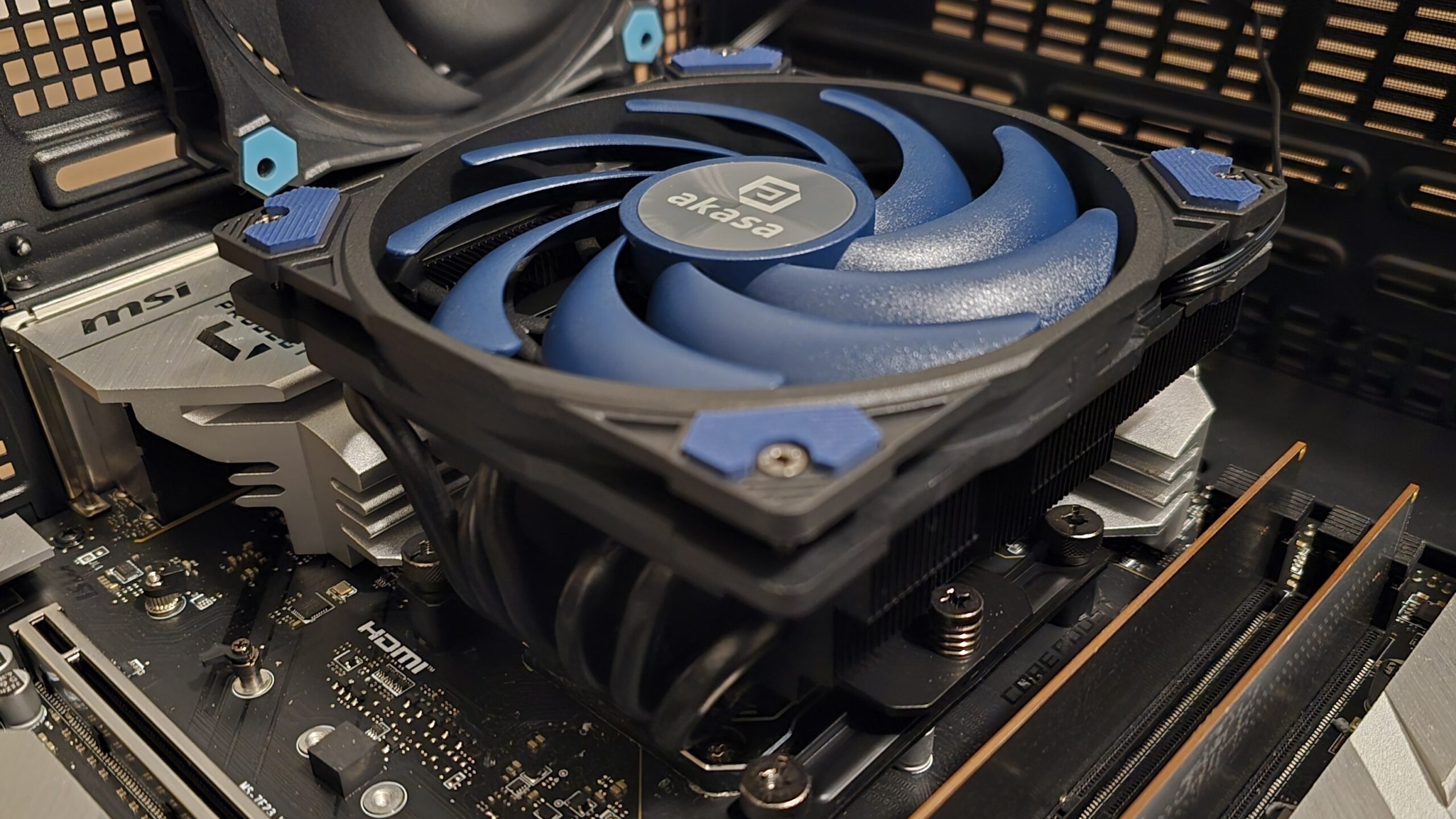We’re looking at another SFF cooler from Akasa with today’s review with the H6L2 M2. This cooler blurs the line between SFF cooler and traditional air cooling, and while not quite as strong as a standard desktop cooler it provides enough cooling performance to keep even the hottest of CPUs under their peak temperatures in common workloads like gaming – even in the most intensive scenarios.
It is important to note that even though we’re testing this product with a full power Intel Core i7-14700K that this cooler is intended for low and medium power CPUs such as AMD’s Ryzen 7 9700x or 7700, typically inside of small form factor systems that typically don’t have a lot of clearance.

As Akasa’s H6L2 M2 (isn’t that a tongue-full?) SFF air cooler isn’t intended for use in the same situations as I’ve tested coolers in the past, I’ll be evaluating this cooler’s performance with different standards than I would a typical desktop cooler. Let’s dive in by going over the packaging of the unit.
Packaging, Contents, and Unboxing

Much like the previously tested Akasa Alucia H4I, the H6LS M2 arrives in a small box just large enough for the cooler, with a dark blue outer theme showcasing the product held inside.

Opening the box reveals the instruction manual and the accessories box.

Inside of the accessories box is an Intel supporting backplate, a 1G medium sized tube of Akasa’s AK-T565 thermal paste, screwdriver, and other mounting parts needed to complete setup and installation of this product.

The design of the unit’s backplate is simple, but it is of sturdy and strong construction – it does not bend under pressure.

Included to cool the heatsink is a low-profile 15mm thick 120mm fan.

If you should desire to use a thicker (standard size) 25mm fan, Akasa includes screws supporting both low-profile and standard sized fans.

Installation
Installing the cooler is fairly simple, but has a few steps.
First you’ll want to take the backplate and press it against the motherboard, and begin to secure it by placing the rubber inner standoffs (shown on the right of the picture below). Afterwards, place the black caps on top of the rubber standoffs (shown on the left side of the picture below).

Place the mounting bars on top of the black caps, and then secure them using the included thumbscrews.

Apply thermal paste, and then place the cooler on top of the CPU block. Use a screwdriver to secure the screws.

The few last steps are to place the 120mm fan on top of the heatsink, and secure it using the included screws and screwdriver. Finally, connect the fan’s PWM cord to an appropriate motherboard header to complete installation.
RAM Clearance
As shown in the picture below, RAM clearance should not be a problem with any system as the cooler does not overhang nor interfere with DIMM slots in any manner.

This is a low height SFF cooler

As you can see from the photo above, this isn’t a very tall cooler – it is designed for small form factor desktops. It is barely taller than the VRM heatsink of the MSI Z790 Project Zero motherboard I’m testing it with for today’s review.
Six heatpipes

To move heat away from the CPU and into the fins of the heatsink, Akasa’s Alucia H6L2 M2 utilizes six copper heatpipes which transfer warmth into a flat heatsink.

Thermal Performance and acoustics
Today’s review won’t be quite as in-depth as my traditional reviews, primarily because this cooler is intended for low power CPUs, most of the tests I traditionally perform won’t be useful information.
This review will cover a wide range of thermal scenarios: maximum performance and noise levels, maximum performance with the noise of the fans normalized to 38.9 dBA, and thermal performance with 120W, 95W, and 65W workloads.
Maximum performance stress testing
To determine the maximum thermal performance of this cooler, I’ve tested it using Intel’s Core i7-14700K and removed the power limits. This is a torture test that this cooler is NOT designed for! When the fans of the cooler were allowed to run at full speed, they reached a volume level of 42.4dBA and cooled 170W on average during testing. This isn’t quite as strong as a single tower air cooler, but it’s much better than the 122W provided by the even smaller Alucia H4i.

Noise normalized
You’ll see that the graph above also includes a measurement for the cooler’s performance when the fans are limited to a relatively quiet 38.9 dBA. This reduces performance from 170W to 154W, which is approximately 10% lower power consumption. I’d personally keep the fans running quietly, but some users might think they need maximum possible performance and won’t mind a noisier fan.
Maximum noise levels

Even letting the fans of this small form factor (SFF) cooler run at their full speeds, the noise level remained a moderately low 42.4 dBA.
65W, 95W, and 120W Thermal results
A small form factor cooler like this isn’t intended for a CPU like Intel’s i7-14700K, but would typically be paired with a CPU that consumes 125W or less of power. I’ve only tested one other SFF cooler recently, so I don’t have many comparison results to offer yet.

With a power limit of 120W, Akasa’s Alucia H6LS M2 remained at a moderately toasty temperature of 76C.

Limiting the CPU to 95W brought temperatures down considerably, averaging a tame 64C.

Dropping the power limits down to 65W provides a much more reasonable, cool temperature of only 54C.
Conclusion

Akasa’s Alucia H6LS M2 is a capable small form factor air cooler that blurs the line between SFF and traditional desktop air cooling, capable of handling 170W in our testing! This level of cooling is strong enough to handle power hungry desktop CPUs like Intel’s i7-14700K in most common scenarios like gaming.
